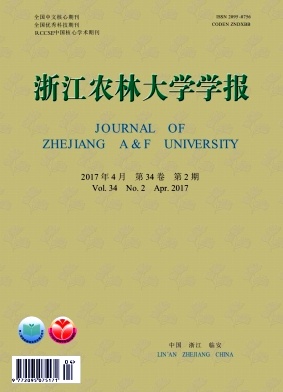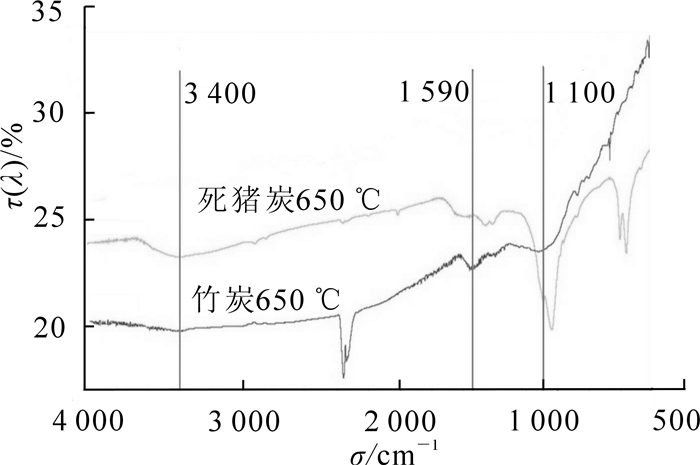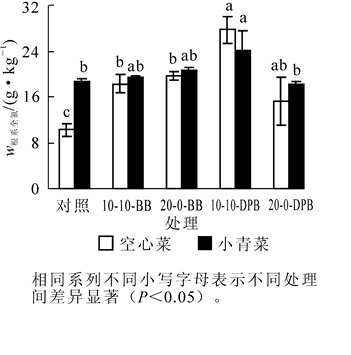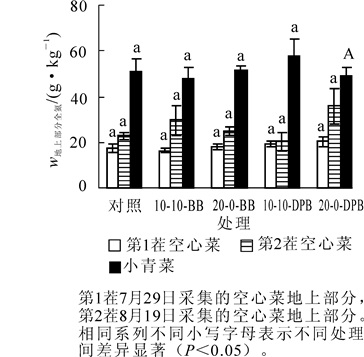-
随着各地农业产业结构调整步伐的加快,设施栽培尤其是大棚蔬菜栽培面积逐年扩大,已成为高效农业的重要组成部分。在蔬菜生产过程中,菜农往往采用过量施加肥料来保证高产,而大量施加氮肥也带来了土壤养分利用率降低[1]、氨挥发加剧[2]以及氧化亚氮(N2O)排放升高[3]等环境问题。近年来,向土壤中添加改良剂以解决不合理施肥带来的一系列环境问题受到了广泛关注[4]。生物质炭是生物质在完全或部分缺氧的环境下经高温热解得到的难熔性固态产物[5]。大部分的生物质炭呈碱性,并具有多孔及较强的吸附能力,故可以有效改善土壤理化性质、固持养分,同时降低土壤养分流失带来的水体富营养化和温室气体排放[6]。生物质炭可以提高土壤对铵态氮(NH4+-N)的吸附能力,有效固持氮肥,减少养分流失[7]。张万杰等[8]在研究秸秆炭与氮肥配施效果的过程中,发现秸秆炭可使菠菜Spinacia oleracea产量增加57.3%。原材料的选择直接影响生物质炭的性质[9]。目前,生物质炭的原材料主要以秸秆、稻壳等植物源为主[10-12],而动物源生物质炭主要以骨炭为主,且对其研究主要集中于重金属吸附方面[13],鲜有对土壤养分及理化性质影响效果方面的研究报道。若能将完整的病死猪作为原材料经高温热解制备成病死猪炭,不仅可以有效解决病死猪处理难的问题,也可为生物质炭原材料的选择提供一个新的来源。在中国长江三角洲区域,为满足蔬菜种植需要,菜地多由水稻田改种而来。在此类设施土壤条件下,生物质炭的田间效果不同于室内培养试验,施用量也难以把握。另外,生物质炭1次施入与2次施入之间的差异如何也尚不清楚。鉴于此,我们选择死猪炭和竹炭作为土壤改良剂,通过田间小区试验研究生物质炭的种类、用量及施用方式对大棚菜地土壤理化性质、蔬菜产量以及蔬菜氮吸收等方面的影响,以期为生物质炭应用于农业生产提供科学依据。
HTML
-
本研究于2015年6-10月在位于浙江省临安市板桥镇花戏村的田间蔬菜大棚中进行。该大棚由水稻田改种而来,具有2 a以上的蔬菜栽培历史。大棚使用面积为8 m × 48 m,土地闲置6个月(2015年1-6月)后进行试验。试验地耕层土壤为砂质黏壤土[V(砂粒):V(黏粒):V(粉粒)=62.0:15.5:22.5],供试耕层土壤(0~200 mm)的基本理化性质为pH(1 : 2.5 H2O)4.23,有机质40.0 g·kg-1,硝态氮66.0 mg·kg-1,铵态氮17.0 mg·kg-1,碱解氮90.0 mg·kg-1,有效磷88.0 mg·kg-1,速效钾109.0 mg·kg-1,电导率0.10 dS·m-1。
供试蔬菜为泰国空心菜Lpomoea aquatica,于2015年6月16日播种,播种后第4天进行间苗,2015年7月29日收获第1茬空心菜,2015年8月19日收获整株,生长周期为65 d。小青菜Brassica chinensis品种为苏州青,于2015年9月9日播种,播种后第7天进行间苗,2015年10月15日收获整株,生长周期为40 d。
供试生物质炭为死猪炭(dead pig biochar,DPB),购买于浙江悟能环保科技发展有限公司。竹炭(bamboo biochar,BB),购买于宁波兴达炭业有限公司。死猪炭和竹炭均在650 ℃缺氧条件下制备。
-
空心菜季各小区内有机肥、尿素、磷肥和钾肥的施加量分别为10 000,150,50和90 kg·hm-2。其中有机肥、磷肥和钾肥作为基肥一次性施入土壤。尿素采用1次基肥和1次追肥的方式,按50%和50%的比例施加,第1茬空心菜收获后开始追肥。小青菜季各小区有机肥、尿素、磷肥和钾肥的施加量分别为6 000,75,50和90 kg·hm-2,均作为基肥一次性施入土壤。
各小区内施加的生物质炭总量均为20 t·hm-2,采用1次施加和2次均施的方式(表 1)。生物质炭的2次均施,第1次与基肥配施于空心菜种植时,第2次于小青菜种植当天施加。本试验共计5个处理,以不施加生物质炭为对照(ck),10-10-DPB,20-0-DPB,10-10-BB和20-0-BB,小区面积为12 m2(3 m × 4 m),重复4次处理,采用随机区组排列方式。田间水分管理采用喷灌方法,在播种及追肥后进行充分喷灌,之后视土壤干湿情况适当浇水。
处理 生物质炭类型 施加量/(t·hm-2) 空心菜 小青菜 总量 对照ck 不添加生物质炭 0 0 0 10-10DPB 死猪炭 10 10 20 20-0-DPB 死猪炭 20 0 20 10-10-BB 竹炭 10 10 20 20-0-BB 竹炭 20 0 20 Table 1. Biochar application rates of different treatments
-
收获每个小区全部的空心菜和小青菜,以地上部鲜质量计产。随机选取具有代表性的植株5株·小区-1,经杀青、烘干、研磨过60目筛后采用浓硫酸-过氧化氢法进行消煮,消煮液用于植物全氮的测定。碱解扩散法[14]测定植物全氮质量分数。
-
蔬菜收获当天,采集每个小区内均匀分布的5点耕层土壤(0~200 mm),挑去肉眼可见的杂质,充分混匀,过2 mm筛。四分法分离出部分土壤用于测定无机氮。其余土壤风干后,用于测定电导率和pH值。土壤无机氮用2 mol·L-1氯化钾溶液浸提。采用紫外分光光度计-双波长法测定硝态氮(NO3--N),靛酚蓝比色法测定铵态氮(NH4+-N);土壤电导率按照V(土):V(水)=1:5,由电导率仪(DDS-307)测定;土壤pH值按照V(土):V(水)=1.0:2.5,由pH计(FE20)测定[14]。
-
生物质炭pH值以V(炭):V(水)=1.0:20测定;生物质炭的碳、氢、氮质量分数用元素分析仪(Flash EA1112, Thermo Finnigan, 意大利)测定;生物质炭电导率是将生物质炭和去离子水按质量体积比1:10混匀,充分搅拌30 min,静置后用电导率仪测定;生物质炭灰分根据美国ASTM标准D1762-84 Standard Test Methed for Chemical Analysis of Wood Charcoal测定。生物质炭比表面积由全自动比表面积和空隙分析仪(TristarⅡ3020, Micromeritica Instrument Corporation, 美国)测定;生物质炭表面官能团用傅里叶变换红外光谱(FTIR, Nicolet is 10, 美国)分析测定。
-
采用Microsoft Excel 2013和Origin 8.0绘制图表,SPSS 21.0软件进行单因素方差分析(analysis of variance, ANOVA)。
1.1. 试验地概况及供试材料
1.2. 试验设计
1.3. 样品的采集与分析测定
1.3.1. 植物产量及养分的测定
1.3.2. 土壤样品采集及基本理化性质的测定
1.3.3. 生物质炭基本性质的测定
1.4. 数据处理
-
死猪炭的pH值和灰分均高于竹炭,且总孔容积为竹炭的24.8倍,比表面积为竹炭的5.4倍。而竹炭的碳氮比(C/N)是死猪炭的10.1倍(表 2)。
生物质炭 pH值 氢/(g·kg-1) 氮/(g·kg-1) 碳/(g·kg-1) 氮/(g·kg-1) 碳氮比 电导率/(dS·m-1) 灰分/% 比表面积/(m2·g-1) 总孔容积/(cm·g-1) 竹炭 (BB) 9.48 1.03 27.90 70.25 0.82 85.70 1.58 26.9 6.00 0.005 死猪炭 (DPB) 10.34 0.81 64.50 31.05 3.64 8.50 5.09 74.8 32.33 0.124 Table 2. PhXsical and chemical properties of biochar
从傅立叶变换红外线光谱分析图谱(图 1)可以看出:死猪炭和竹炭在3 400 cm-1,1 590 cm-1和1 100 cm-1处都具有吸收峰,表明2种生物质炭表面均含有羟基(—OH),羧基(—COOH)和碳酸根(CO32-)等含氧官能团[15],且死猪炭所呈现出的吸收峰强度高于竹炭,说明死猪炭表面含有较多的羟基和碳酸根。死猪炭灰分含量是竹炭的2.8倍,也表明其表面以氧化物或碳酸盐形式存在的钾、钙、钠、镁等矿质元素含量远高于竹炭。
-
与对照(ck)相比,1次施用死猪炭处理显著(P<0.05)提高了空心菜和小青菜季土壤pH值,而2次施用竹炭的处理仅提高了小青菜季土壤pH值,且与1次施用竹炭处理相比,2次施用处理下小青菜季土壤pH值显著(P<0.05)升高(表 3)。死猪炭的2种不同施炭方式对土壤pH值无差异影响。与对照相比,1次施用死猪炭处理显著(P<0.05)提高了第1茬空心菜土壤电导率,所有生物质炭处理对第2茬空心菜土壤电导率均无显著性影响。与对照相比,2次施用猪炭处理可使小青菜季土壤电导率提高50%,而1次施用猪炭处理对土壤电导率无显著性影响。1次施用竹炭处理显著(P<0.05)提高了土壤电导率,而2次施用处理下土壤电导率却表现出下降趋势。
处理 pH值 电导率/(dS·m-1) 空心菜 小青菜 空心菜 小青菜 第1茬 第2茬 第1茬 第2茬 对照ck 4.22±0.07 b 4.24±0.02 b 4.95±0.10 b 0.17±0.03 b 0.20±0.01 a 0.14±0.02 b 10-10-BB 4.44±0.15 ab 4.40±0.15 ab 5.40±0.06 a 0.16±0.03 b 0.25±0.03 a 0.09±0.02 c 20-0-BB 4.48±0.08 ab 4.37±0.09 ab 4.97±0.10 b 0.18±0.05 b 0.23±0.06 a 0.20±0.02 a 10-10-DPB 4.44±0.32 ab 4.34±0.05 ab 5.16±0.06 ab 0.24±0.06 ab 0.28±0.07 a 0.21±0.04 a 20-0-DPB 4.70±0.57 a 4.61±0.16 a 5.38±0.12 a 0.32±0.06 a 0.27±0.04 a 0.12±0.01 bc 说明:第1茬7月29日采集的耕层土壤样品; 第2茬8月19日采集的耕层土壤样品。同列不同小写字母表示不同处理间差异显著 (P<0.05) Table 3. Effects of biochar treatments on soil pH and electrical conductivity
-
由表 4可知:与对照相比,2次施用竹炭处理显著(P<0.05)降低了第1茬空心菜土壤的铵态氮(NH4+-N)质量分数。死猪炭和竹炭的施用对第2茬空心菜土壤的铵态氮质量分数无显著影响。与对照相比,2次施用竹炭处理下小青菜季土壤铵态氮质量分数降低了22.7%,而死猪炭的施用对土壤铵态氮质量分数无显著影响。2种生物质炭对土壤硝态氮质量分数无显著影响。
处理 硝态氮/(mg·kg-1) 铵态氮/(mg·kg-1) 空心菜 小青菜 空心菜 小青菜 第1茬 第2茬 第1茬 第2茬 对照ck 114±23 ab 196±32 a 203±23 a 21.29±1.81 a 28.16±13.62 a 7.36±1.22 a 10-10-BB 71±13 b 205±50 a 223±128 a 11.54±2.38 b 24.94±7.45 a 5.63±0.97 b 20-0-BB 103±23 ab 175±65 a 184±8 a 14.56±2.74 ab 25.83±11.79 a 8.01±0.96 a 10-10-DP 139±36 a 198±74 a 129±19 a 19.16±5.46 a 23.47±11.00 a 6.64±0.24 ab 20-0-DPB 110±27 ab 189±72 a 197±51 a 16.90±4.36 ab 16.16±6.44 a 6.54±0.13 ab 说明:同列不同小写字母表示不同处理间差异显著 (P<0.05) Table 4. Effect of biochar treatments on contents of nitrate and ammonium in the soils
-
1次施用死猪炭处理下的空心菜第1茬产量最高,且显著(P<0.05)高于死猪炭2次施用处理(图 2)。而竹炭的2次与1次施用处理均显著(P<0.05)降低了第1茬空心菜的产量,分别降低了49.5%和52.5%。与对照相比,1次施用死猪炭能够显著(P<0.05)提高第2茬空心菜的产量,死猪炭的2次与1次施用处理分别使小青菜产量提高44.14%和47.38%。整个轮作周期中,竹炭的1次施用与2次施用处理之间无显著性差异。
-
与对照相比,死猪炭的2种处理与竹炭的2种处理均显著(P<0.05)提高了空心菜根系的总氮质量分数,分别提高了171%,121%,78%和92%(图 3)。对于小青菜季,仅2次施用死猪炭处理显著(P<0.05)提高了小青菜根系总氮质量分数,与对照和1次施用死猪炭处理相比,分别提高了29.5%和42.7%。竹炭的施用对小青菜季植物根系的总氮质量分数无显著性影响。
-
从图 4可以看出:与对照相比,死猪炭和竹炭对空心菜-小青菜轮作期间蔬菜地上部总氮质量分数没有显著影响,且死猪炭和竹炭的2种施用方式间无显著性差异。
2.1. 死猪炭和竹炭的理化性质
2.2. 生物质炭对土壤pH值和电导率的影响
2.3. 生物质炭对土壤硝态氮和铵态氮质量分数的影响
2.4. 生物质炭对蔬菜产量的影响
2.5. 生物质炭对蔬菜根系氮质量分数的影响
2.6. 生物质炭对蔬菜地上部氮质量分数的影响
-
与对照相比,本研究中1次施用死猪炭处理能够提高土壤的pH值。张祥等[16]研究发现:随着花生Arachis hypcgaea壳炭施加量的增加,黄棕壤的pH值也随之增加。死猪炭的pH值、灰分及表面官能团均高于竹炭,因此,对土壤pH值的影响也更为显著。刘玉学等[17]研究发现:在pH 6.82的土壤上,仅一次性高施加量(20,40 t·hm-2)的竹炭可以显著(P<0.05)提高土壤pH值。本试验中竹炭的添加量最大为20 t·hm-2,且土壤pH值仅为pH 4.23,因此,本研究中1次施用竹炭处理对提高土壤pH值并无显著性效果。本研究中,追施竹炭后,2次均施竹炭处理对提高苏州青土壤pH值的效果优于1次施用处理。这可能是由于生物质炭施入土壤一段时间后会发生老化行为,老化后的生物质炭对土壤pH值的影响开始逐渐减弱[18]。
在设施栽培中,由于土壤长期得不到雨水淋洗,土壤盐分容易积累[19]。添加生物质炭后,除生物质炭本身携带的盐基离子外,还可以通过生物质炭自身的吸附性,降低土壤水分的淋失,提高土壤含水率[20],从而使得土壤溶液中盐基离子在土壤中富集,提高土壤电导率。随着生物质炭施用量的增加,土壤对水分的吸附能力也增强,因此,对提升土壤电导率的效果也越明显。由于本研究中选择的竹炭本身电导率较低,因而对空心菜季土壤电导率无显著性影响。虽然死猪炭和竹炭的施加不同程度地提高了土壤电导率,但供试土壤仍未达到轻微盐渍土[21]的含盐量,因而并不影响蔬菜的生长。
生物质炭对土壤铵态氮的吸附能力受土壤酸碱性的影响,在土壤pH值接近中性时,生物质炭对铵离子(NH4+)和氨(NH3)吸附能力才能发挥出来[22]。在本研究中,由于土壤本身酸性较强,生物质炭的施加降低了土壤的酸度,引起了铵态氮的大量挥发。因此1次施用死猪炭的处理对土壤铵态氮质量分数没有显著影响,随着添加量的增加,土壤pH值显著(P<0.05)提高,促进了土壤氨挥发量的增加,这可能与其对铵态氮吸附固持作用相互抵消,从而对土壤铵态氮质量分数无显著影响。竹炭具有较高的碳氮比,而生物的固氮能力与土壤碳氮比值呈正比[23],因此,可以显著降低土壤中铵态氮质量分数。
施加死猪炭和竹炭对土壤硝态氮质量分数没有显著影响,这与陈心想等[24]研究发现生物质炭的施加显著(P<0.05)提高土壤铵态氮和硝态氮质量分数结果不同。原因可能是由于本研究菜地在使用前经过半年的闲置、曝晒,土壤本身的通气条件较好,因而土壤本身进行了较强的硝化反应[25],故施加2种生物质炭对土壤的硝化速率影响甚微。另一方面,由于整个轮作期时间较短(105 d),同时所选用生物质炭的粒径为3 mm,从而导致生物质炭与土壤的相互作用时间较短、接触面积较小、生物质炭表面的氧化程度较低,因此,对提高土壤硝态氮和铵态氮质量分数的效果不显著。
-
死猪炭和竹炭对蔬菜产量的影响与施加量有关。生物质炭对蔬菜产量的影响不仅与其对土壤养分的吸附固持能力有关,也可能是生物质炭的施加促进了土壤中有益菌群数量的增加,增强了土壤的生态功能[26-27]。有研究表明:生物质炭施入土壤后会降低土壤容重[28],增加土壤的持水能力,并改善土壤酸性状况,更有利于根系的生长发育与生理功能的协同发展[17],而生物质炭的施加也会改变土壤中养分(磷、钾、钙和镁)的有效性[29],从而促进产量的增加。
在本研究中,竹炭处理导致第1茬空心菜产量显著(P<0.05)降低。这可能是由于竹炭在制备过程中存在大量焦油和树脂等,附着在生物质炭表面,从而抑制作物的生长[30]。随着时间推移,土壤中生物质炭表面发生老化,其表面含氧官能团和阳离子交换量均有增加[31],所以在第2茬空心菜及小青菜生长季,施加竹炭处理对其产量无显著影响。可见,生物质炭对作物产量的影响受到多种因素的交互作用,所以其对产量的具体影响机制和作用效果尚不明确。
-
生物质炭对蔬菜根系全氮质量分数的影响不仅与施加量有关,还与生物质炭种类有关。生物质炭的施加可以改善干旱条件下土壤的紧实度,增加土壤的孔隙度[32],死猪炭相比较于竹炭具有较高的比表面积,因此,随着施加量的增加可以更好地降低土壤容重,促进根系生长[33],从而提高作物对养分的吸收。而生物质炭在水土交融下释放出的乙烯、激素类物质对根系生长也会产生影响[34]。并且,生物质炭施入土壤后,在提高土壤pH值的同时,由于其表面的氢氧根离子(OH-)与硝酸根(NO3-)有竞争作用[35],也会影响植物根系的氮吸收能力。
死猪炭和竹炭的施加对空心菜和小青菜2种蔬菜植株总氮质量分数均没有显著影响,与张晗芝等[36]的研究结果一致。本研究中使用的生物质炭具有较高的含氮量,由于制备生物质炭温度高于500 ℃时,氮将不具有生物有效性,植物也无法吸收、利用[37]。同时,本研究中2种生物质炭具有较高的碳氮比,施入土壤后,可能会导致氮的固定,降低土壤氮的有效性,限制植物对其吸收[38]。
3.1. 生物质炭对土壤理化性质的影响
3.2. 生物质炭对空心菜-小青菜轮作下蔬菜产量的影响
3.3. 生物质炭对植物氮吸收的影响
-
1次施用死猪炭的处理能够显著(P<0.05)提高空心菜和小青菜季土壤pH值,而竹炭处理对土壤pH值无影响。死猪炭处理能够显著(P<0.05)提高小青菜产量,而竹炭处理下第1茬空心菜产量显著(P<0.05)下降。1次施用死猪炭和竹炭处理可显著(P<0.05)提高空心菜根系全氮质量分数,2次施用死猪炭处理显著(P<0.05)提高了小青菜根系全氮质量分数。与2次施用相比,1次施用死猪炭的方式更为经济合理。











 DownLoad:
DownLoad:


